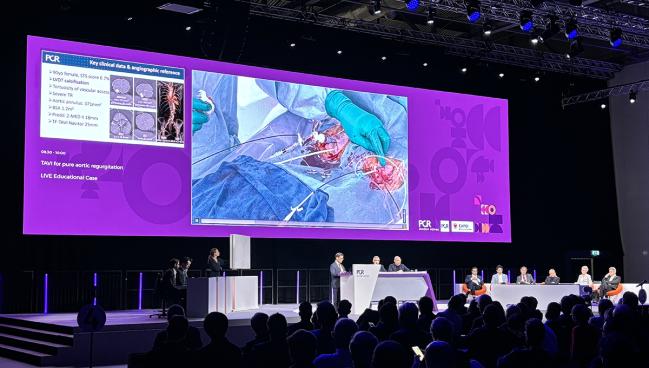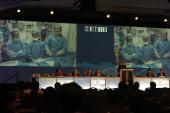Live Valve Cases Safe, With Outcomes Comparable to Trials and Practice
These data should help reassure those concerned with the risks of educating physicians through live cases at medical meetings.

LONDON, ENGLAND—Live interventional cardiology cases, like the ones beamed to meeting attendees this week at PCR London Valves 2024, are associated with excellent clinical outcomes and a low rate of complications, a study presented here suggests.
Outcomes in these cases, which often involve experienced operators showcasing advanced skills in complex patients, were on par with results achieved in daily clinical practice, registries, or randomized clinical trials, reported investigators during a hotline session on the meeting’s first day.
“The headline is that the technical outcomes were very good and serious complications were very infrequent,” lead investigator Christopher Allen, MD (Cedars-Sinai Medical Center, Los Angeles, CA), told TCTMD. “One point that I would emphasize is that [the study] is from 2010 onwards, so for TAVI, this is really the beginning of the procedure with the high-risk cohort and a lot of transapical [access] procedures.”
Despite that, the risk of major adverse cardiac events in more than 90 TAVI procedures performed as live cases was 3.0%, he reported.
“These are patients in whom you’re going into the procedure expecting it to be pretty high risk and the outcomes are very, very good.”
For years, a big draw at interventional and structural cardiology meetings has been live case sessions. At the recent TCT 2024 conference, there were 33 endovascular, structural, and coronary cases, while PCR London Valves is hosting seven “live educational cases” from three experienced, high-volume centers: Clinique Pasteur in Toulouse, France; St. Thomas’ Hospital in London, England; and the University Hospital of Cologne, Germany.
The PCR London Valves sessions include a range of procedures, such as TAVI for aortic regurgitation, mitral transcatheter edge-to-edge repair (TEER), transcatheter mitral valve replacement (TMVR), tricuspid TEER, and transcatheter tricuspid valve replacement.
“As a fellow, we find live cases very valuable,” said Allen. “They’re always among the most packed sessions at any conference, but people have reasonable questions to answer over whether the educational side of it is justifiable if there’s increased procedural risk. When we started looking into this, there is a surprising lack of systematically collected data that’s been presented or published. We couldn’t find anything for more than a decade and certainly nothing that includes the new transcatheter procedures.”
As Good as PARTNER 3
More than 20 years ago during a live case presented at TCT, in the earliest days of transcatheter aortic valve replacement, a patient died after developing mitral regurgitation and severe pump failure shortly after placement of the device. That case made the news and led to some questions around the ethics of live case demonstrations. Several professional organizations eventually issued statements on the appropriateness of live cases and set out recommendations on patient safety, proper case selection, and educational effectiveness.
In this new study, Allen and colleagues assessed the safety of patients undergoing transcatheter valve interventions during live case demonstrations conducted over 14 years at PCR London Valves. The majority of patients underwent TAVI (n = 91), but there were 13 TMVR live cases, six mitral TEER demonstrations, and a handful of transcatheter valve interventions. The cohort was elderly (mean age 80 years) with comorbidities reflective of a predominantly high-risk surgical population: EuroSCORE II 8% and STS Score 9%.
In the TAVI live cases, technical success was 99%, with very low rates of vascular injury and major bleeding. The 30-day mortality rate was 3%. These results were on par with outcomes in PARTNER 2, a comparator group chosen to capture TAVI outcomes after operators were more experienced with the procedure. Similarly, the live case outcomes were just as good when compared with a real-world daily practice cohort of 346 consecutive TAVI cases treated at St. Thomas’ Hospital.
With the 13 live case TMVRs, which included a mix of device types, technical success was 92%, with a low rate of major complications and no deaths at 30 days. These results were as good as those seen in similar patients treated in the STS/ACC TVT registry, said Allen. Mitral TEER live cases were also safe, with no patient left with more than mild mitral regurgitation and no major adverse cardiac events at 30 days.
In all the live cases, despite high levels of baseline risk, the outcomes were “excellent,” said Allen. “In carefully planned cases, when treated by an experienced team, live broadcasts do not compromise patient safety,” he said.
What Can’t Go Live? Probably Nothing
During the panel discussion, Christopher Meduri, MD (Karolinska University Hospital, Stockholm, Sweden), said these new data are reassuring, noting that interventional cardiologists continue to learn from live demonstrations. He questioned, however, whether everything was fair game for a live case or if there might be some procedures that shouldn’t be broadcast in real time.
Allen stressed that when course directors are planning live demonstrations, they are drilled on whether it may be appropriate for a live case, saying it approximates a second heart team meeting. If the team has the expertise and experience, and they can perform the procedure safely and effectively within the transmission time, he believes, there’s no one case that couldn’t be considered.
“It’s a short way of saying we need to tailor it based on the individual center and procedure,” said Allen.
Meduri agreed, telling TCTMD that operators, facilities, and course directors are venturing “to take a big enough bite that the [live case] is interesting, but not such a big bite that you’re really exposing any additional risk to the patient.” Live case operators shouldn’t be doing anything they wouldn’t be comfortable doing if the “boss is watching,” he said.
The US Food and Drug Administration requires prior authorization if an investigational device will be used during a live case, but Meduri noted that some interventional trials have struggled with enrollment. He questioned if it might be possible to expose the community to the device/procedure without being promotional or putting patients at risk.
Allen said this is a hot topic, adding that he’s hopeful their data can help aid those conversations going forward.
“We’ve had a couple of trials that have struggled to recruit or had slower recruitment than we’d like and perhaps featuring it in an educational meeting like this would help,” he said. “I think as we get more aggregate data showing the outcomes of live cases more broadly, that should be a conversation we start having.”
Michael O’Riordan is the Managing Editor for TCTMD. He completed his undergraduate degrees at Queen’s University in Kingston, ON, and…
Read Full BioSources
Allen C. Live case interventional cardiology procedures are safe: outcomes from a multicenter registry. Presented at: PCR London Valves. November 24, 2024. London, England.





Comments